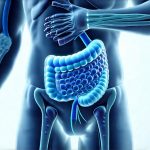Digestive issues are incredibly common, affecting millions worldwide. From occasional bloating and gas to chronic conditions like irritable bowel syndrome (IBS) and inflammatory bowel disease (IBD), the spectrum of discomfort is vast. Often, these symptoms aren’t simply a matter of food sensitivities or poor choices; they can be indicative of underlying inflammation within the digestive tract. Many conventional treatments focus on managing symptoms rather than addressing the root cause, leaving individuals searching for more holistic and sustainable solutions. Understanding the connection between diet and inflammation is therefore crucial for those seeking long-term digestive health.
The good news is that dietary changes can often play a significant role in mitigating digestive distress. An anti-inflammatory diet isn’t about deprivation or strict rules; it’s about nourishing your body with foods that reduce inflammation, support gut health, and ultimately ease symptoms. It’s a proactive approach, recognizing that what you eat directly impacts how you feel. This article will explore the principles of an anti-inflammatory diet specifically geared towards managing digestive symptoms, offering practical guidance for implementation and long-term success. We’ll examine key food groups to embrace and avoid, as well as strategies for incorporating these changes into your daily life.
Understanding Inflammation & The Gut
Inflammation is a natural process; it’s the body’s way of protecting itself from injury or infection. However, chronic inflammation – that which persists over long periods – can contribute to a host of health problems, including digestive disorders. In the gut, inflammation can disrupt the delicate balance of the microbiome (the community of bacteria living in your digestive tract), impair nutrient absorption, and damage the intestinal lining. This disruption creates a vicious cycle: inflammation leads to symptoms, which often lead to further dietary imbalances that exacerbate inflammation. Several factors contribute to chronic gut inflammation, including diet, stress, lack of sleep, and environmental toxins.
The link between diet and inflammation is particularly strong. Foods high in processed sugars, refined carbohydrates, and unhealthy fats can promote inflammatory responses. Conversely, foods rich in antioxidants and omega-3 fatty acids have anti-inflammatory properties. The gut microbiome plays a central role here; it’s heavily influenced by dietary choices. A diverse and healthy microbiome is better equipped to regulate inflammation and maintain gut barrier integrity. Supporting your microbiome through diet is therefore paramount for managing digestive symptoms and promoting overall well-being.
Moreover, food sensitivities can often trigger inflammatory responses in the gut. These aren’t necessarily allergies (which involve an immune system reaction), but rather intolerances that cause discomfort and inflammation when certain foods are consumed. Identifying and eliminating these trigger foods – even temporarily – can significantly reduce digestive symptoms. This is where mindful eating and potentially working with a healthcare professional become invaluable. If you often struggle after meals, consider ease digestive symptoms.
Core Principles of An Anti-Inflammatory Diet for Digestion
An anti-inflammatory diet isn’t one-size-fits-all, but certain principles apply universally when aiming to soothe the digestive system. The cornerstone is prioritizing whole, unprocessed foods. This means focusing on fruits and vegetables (especially brightly colored ones rich in antioxidants), lean proteins, healthy fats, and fiber-rich carbohydrates. Reducing or eliminating processed foods, sugary drinks, refined grains, and excessive amounts of red meat are also key steps. Hydration is equally important; drinking plenty of water helps maintain gut motility and supports overall digestive function.
Beyond the basics, several dietary strategies can further reduce inflammation in the gut:
– Incorporate probiotic-rich foods like yogurt (if tolerated), kefir, sauerkraut, kimchi, and kombucha to support a healthy microbiome.
– Include prebiotic foods like onions, garlic, asparagus, bananas, and oats, which feed beneficial bacteria in the gut.
– Embrace anti-inflammatory spices such as turmeric, ginger, cinnamon, and cloves. These contain compounds that have powerful antioxidant and anti-inflammatory properties.
– Consider incorporating omega-3 fatty acids from sources like fatty fish (salmon, mackerel, sardines), flaxseeds, chia seeds, and walnuts.
It’s also important to understand the concept of food combining. While not universally accepted, some individuals find relief by avoiding combinations that are difficult to digest, such as fruit with meals or large amounts of protein and carbohydrates together. Experimenting with different approaches can help identify what works best for your body. If you’re on a restrictive diet like keto, learning manage bloating is essential.
Identifying & Eliminating Trigger Foods
One of the most effective ways to manage digestive symptoms is to pinpoint foods that trigger inflammation or discomfort. This often involves an elimination diet, a structured process where you temporarily remove potentially problematic foods from your diet and then reintroduce them one at a time to observe any reactions.
Here’s a general approach:
1. Eliminate common trigger foods for 2-3 weeks, including gluten, dairy, soy, corn, eggs, sugar, alcohol, caffeine, and processed foods.
2. Slowly reintroduce each food individually, monitoring for symptoms like bloating, gas, diarrhea, constipation, or abdominal pain. Keep a detailed food journal to track your responses.
3. If you experience symptoms after reintroducing a food, remove it from your diet again.
It’s important to note that elimination diets can be challenging and are best undertaken with the guidance of a registered dietitian or healthcare professional. They can help ensure you’re still getting adequate nutrition during the process and interpret your results accurately. Don’t attempt self-diagnosis without proper support. Learning safely reintroduce foods is key here.
Food sensitivities differ from allergies, making diagnosis trickier. Allergies trigger an immediate immune response, whereas sensitivities often have delayed effects. This makes it harder to connect symptoms with specific foods. However, careful observation and tracking are key. Remember that even seemingly healthy foods can be triggers for some individuals. For instance, certain high-FODMAP fruits and vegetables (fermentable oligosaccharides, disaccharides, monosaccharides, and polyols) can cause digestive upset in people with IBS.
The Role of Fiber & Gut Health
Fiber is essential for a healthy digestive system, but the type of fiber matters. Insoluble fiber adds bulk to stool and helps move waste through the digestive tract, while soluble fiber dissolves in water and forms a gel-like substance that can slow digestion and promote regularity. Both types are important, but individuals with certain digestive conditions may need to adjust their intake based on tolerance.
For example, those with IBS often benefit from a low-FODMAP diet, which restricts certain types of fermentable carbohydrates found in many high-fiber foods. This doesn’t mean eliminating fiber altogether; it means choosing lower-FODMAP alternatives like oats, quinoa, carrots, and blueberries. Gradually increasing fiber intake is also crucial to avoid exacerbating symptoms.
Beyond the type of fiber, supporting your gut microbiome through dietary choices is paramount. A diverse microbiome thrives on a variety of plant-based foods. Prebiotic fibers, found in foods like onions, garlic, asparagus, and bananas, act as food for beneficial bacteria. Fermented foods, rich in probiotics, further enhance microbial diversity. Prioritizing these foods can significantly improve gut health and reduce inflammation.
Mindful Eating & Stress Management
Diet is only one piece of the puzzle when it comes to managing digestive symptoms. Mindful eating – paying attention to your body’s hunger and fullness cues, savoring each bite, and avoiding distractions during meals – can dramatically improve digestion. Eating quickly or while stressed can disrupt the digestive process and lead to discomfort.
Stress management is equally vital. Chronic stress can negatively impact gut health by altering the microbiome, increasing intestinal permeability (often referred to as “leaky gut”), and exacerbating inflammation. Techniques like meditation, yoga, deep breathing exercises, and spending time in nature can help reduce stress levels and promote digestive well-being.
Establishing regular meal times and creating a calm eating environment can also be beneficial. Avoid eating late at night, as this can disrupt sleep and digestion. If you’re experiencing issues while traveling without triggering symptoms, these tips are even more critical. Ultimately, taking a holistic approach that addresses both diet and lifestyle factors is the most effective way to manage digestive symptoms and achieve long-term health. It’s about cultivating a harmonious relationship with your body and prioritizing its needs. Learning manage reactions at work can also help you stay on track. Finally, remember to ease symptoms after heavy meals.


















